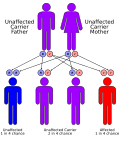Adducted thumb syndrome
| Adducted thumb syndrome | |
|---|---|
| Synonyms | Adducted thumb-clubfoot syndrome |
| Pronounce | N/A |
| Specialty | N/A |
| Symptoms | Adducted thumb, clubfoot, cleft palate, scoliosis |
| Complications | N/A |
| Onset | Congenital |
| Duration | Lifelong |
| Types | N/A |
| Causes | Genetic mutation |
| Risks | Family history |
| Diagnosis | Clinical examination, genetic testing |
| Differential diagnosis | N/A |
| Prevention | N/A |
| Treatment | Orthopedic surgery, physical therapy |
| Medication | N/A |
| Prognosis | N/A |
| Frequency | Rare |
| Deaths | N/A |
Adducted thumb syndrome, also known as adducted thumb-clubfoot syndrome, is a rare genetic disorder characterized by the presence of adducted thumbs, clubfoot, and other associated anomalies. This condition is congenital, meaning it is present at birth, and is caused by mutations in specific genes.
Signs and Symptoms[edit]
Individuals with adducted thumb syndrome typically present with:
- Adducted thumb: The thumb is held in a flexed position across the palm.
- Clubfoot: A deformity where the foot is twisted out of shape or position.
- Cleft palate: An opening or split in the roof of the mouth.
- Scoliosis: A sideways curvature of the spine.
Causes[edit]
Adducted thumb syndrome is primarily caused by genetic mutations that affect the development of the limbs and other parts of the body. These mutations can be inherited from a parent or occur spontaneously.
Diagnosis[edit]
Diagnosis of adducted thumb syndrome is based on a combination of clinical examination and genetic testing. A healthcare provider will assess the physical signs and may order genetic tests to confirm the diagnosis.
Treatment[edit]
Treatment for adducted thumb syndrome often involves a multidisciplinary approach, including:
- Orthopedic surgery: To correct deformities such as clubfoot.
- Physical therapy: To improve mobility and function.
Prognosis[edit]
The prognosis for individuals with adducted thumb syndrome varies depending on the severity of the symptoms and the success of treatment interventions. Early diagnosis and treatment can improve outcomes.
See Also[edit]
References[edit]
<references/>
External Links[edit]
- [Genetic and Rare Diseases Information Center](https://rarediseases.info.nih.gov/)
-
Adducted thumb syndrome
Ad. Transform your life with W8MD's Budget GLP-1 injections from $75


W8MD offers a medical weight loss program to lose weight in Philadelphia. Our physician-supervised medical weight loss provides:
- Weight loss injections in NYC (generic and brand names):
- Zepbound / Mounjaro, Wegovy / Ozempic, Saxenda
- Most insurances accepted or discounted self-pay rates. We will obtain insurance prior authorizations if needed.
- Generic GLP1 weight loss injections from $75 for the starting dose.
- Also offer prescription weight loss medications including Phentermine, Qsymia, Diethylpropion, Contrave etc.
NYC weight loss doctor appointmentsNYC weight loss doctor appointments
Start your NYC weight loss journey today at our NYC medical weight loss and Philadelphia medical weight loss clinics.
- Call 718-946-5500 to lose weight in NYC or for medical weight loss in Philadelphia 215-676-2334.
- Tags:NYC medical weight loss, Philadelphia lose weight Zepbound NYC, Budget GLP1 weight loss injections, Wegovy Philadelphia, Wegovy NYC, Philadelphia medical weight loss, Brookly weight loss and Wegovy NYC
|
WikiMD's Wellness Encyclopedia |
| Let Food Be Thy Medicine Medicine Thy Food - Hippocrates |
Medical Disclaimer: WikiMD is not a substitute for professional medical advice. The information on WikiMD is provided as an information resource only, may be incorrect, outdated or misleading, and is not to be used or relied on for any diagnostic or treatment purposes. Please consult your health care provider before making any healthcare decisions or for guidance about a specific medical condition. WikiMD expressly disclaims responsibility, and shall have no liability, for any damages, loss, injury, or liability whatsoever suffered as a result of your reliance on the information contained in this site. By visiting this site you agree to the foregoing terms and conditions, which may from time to time be changed or supplemented by WikiMD. If you do not agree to the foregoing terms and conditions, you should not enter or use this site. See full disclaimer.
Credits:Most images are courtesy of Wikimedia commons, and templates, categories Wikipedia, licensed under CC BY SA or similar.
Translate this page: - East Asian
中文,
日本,
한국어,
South Asian
हिन्दी,
தமிழ்,
తెలుగు,
Urdu,
ಕನ್ನಡ,
Southeast Asian
Indonesian,
Vietnamese,
Thai,
မြန်မာဘာသာ,
বাংলা
European
español,
Deutsch,
français,
Greek,
português do Brasil,
polski,
română,
русский,
Nederlands,
norsk,
svenska,
suomi,
Italian
Middle Eastern & African
عربى,
Turkish,
Persian,
Hebrew,
Afrikaans,
isiZulu,
Kiswahili,
Other
Bulgarian,
Hungarian,
Czech,
Swedish,
മലയാളം,
मराठी,
ਪੰਜਾਬੀ,
ગુજરાતી,
Portuguese,
Ukrainian
